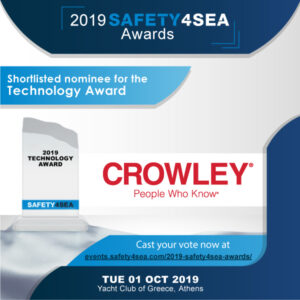While the voting procedure for the 2019 SAFETY4SEA Awards is open, Captain Bren Wade, Manager, Marine Compliance, Crowley Maritime Corp. explains how leading- edge technology can make a difference in navigation and refers to Crowley’s mariner assessment program that offers a computerized simulation environment for which the company has been shortlisted for the Technology Award. Furthermore, Capt. Wade reveals that in the future there are plans to add more functions for a more holistic approach to Navigation Assessments, i.e. to assess an entire bridge team together in the simulator, from the helmsman to the Master.
SAFETY4SEA: Your organization has been shortlisted for the 2019 SAFETY4SEA Awards in the ‘Technology’ category alongside a number of other distinguished nominees. What would you like to share with industry’s stakeholders with respect to this development?
Capt. Bren Wade: Crowley is honored to be recognized with other top technical companies in our industry, many we work with on a regular basis. Safe and reliable operations are fundamental to the way we work. It is important for us as industry leaders to ensure that our mariners have the confidence and skillsets required to operate their vessels at the highest level. Whether this involves propulsion, control and navigation systems, procurement and communications systems, or training, it is imperative that we continue to manage the risk faced onboard ships and, in our ports and terminals, through better use of leading-edge technology.
S4S: What is the key feedback from your existing & prospective clients on the barriers and drivers towards investing into your technology?
Capt. Br.W.: For most customers, seeing is believing. The program was initially developed to meet specific internal skillset requirements. The benefits were immediately realized. The program expanded organically to all operating business units. Data collection and analysis allowed us to share specific competency shortfalls with maritime training schools, academies, regulatory agencies and Class Societies. Crowley then began introducing it to our third-party managed customers. Initially there was reluctance to accept the additional cost, but the data results were compelling and adoption within our other managed fleets quickly followed. To ensure a broader implementation of the program, all facilities capable of hosting the assessments were granted permission to utilize the process for the broader mariner population.
S4S: Do you have any new projects on the pipeline and/or plans that you would like to share with the rest of the industry?
Capt. Br.W.: Crowley is currently focusing its efforts on a more holistic approach to Navigation Assessments. To do this Crowley plans to assess an entire bridge team together in the simulator, from the helmsman to the Master. These assessments will be more realistic than anything attempted prior. The challenge remains to give all participants a comprehensive assessment and debrief that can used to improve watch-standing skills.
S4S: If you could change one thing about the shipping industry, what would it be and why?
Capt. Br.W.: Crowley is pleased to be recognized for our industry leading Navigation and Engineering Assessment programs which have been in place for more than five years. These programs have been instrumental in identifying opportunities for improvement and have had a positive impact on fleet performance. Today, we see an opportunity to expand these programs to include assessment of other critical evolutions in vessel operations; liquid bulk transfer, for example. To continue this path of continuous improvement, it is important that we focus our resources on areas of high impact. With this in mind, Crowley would like to see faster adoption of anonymous reporting systems within the industry to capture lessons learned without fear of reprisal. A robust reporting system would allow the industry to identify those areas that would provide the most value for investment in training and assessment.
S4S: What is your key message to the industry for enhancing safety culture onboard and ashore?
Capt. Br.W.: From the CEO down, it is imperative the leadership of the company believe and support continual improvement in safety. Not only will their efforts be visible for others to follow, but their commitment will find its way into the company’s DNA. Furthermore, having the right people, who care about each other and are engaged, fosters a culture where people work safely not because they’re told to, but because they want to. Communication is key. Some of the best solutions come from the deck plates, but without a strong communication bridge from ship to shore, they would never be realized. And though solutions to fix persistent cultural issues are available in the technology around us, there are no magic bullets. A change in culture takes innovative solutions and the fortitude to see them through.
You may cast your vote for Crowley Maritime Corp. at 2019 SAFETY4SEA Awards dedicated webpage till 6th of September 2019!
The views presented hereabove are only those of the author and not necessarily those of SAFETY4SEA and are for information sharing and discussion purposes only.































































